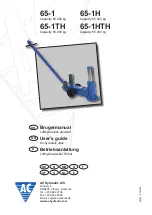
12
Critical Cautions
Our tugs do not instantly stop.
This feature is to protect your aircraft’s
landing gear. Failure to compensate for this soft stop can cause damage to
your aircraft. “Slowly” is the word to live by when you are in tight spaces or
loading the tug. We recommend practicing with the tug before using it on
your aircraft to allow familiarization with this soft stop feature. Exception:
E-Stop stops the tug NOW! An emergency stop can damage the landing
gear and damage the tug’s motor control module. The “E” in E-stop stands
for EMERGENCY.
Chock your mains!
You don’t want to push your aircraft into the hanger
wall...
During operation, be aware of your surroundings.
Never put your-
self between the tug and any object! A tug capable of pushing thousands
of pounds of aircraft can push you against an obstacle with thousands of
pounds of pressure. There is a risk of serious injury, death, or dismember-
ment. Proper operation is your responsibility.
Best Tugs™ tugs do not have secondary brakes.
The motor/trans-
mission provides all braking. Your aircraft can roll freely if your transmission
fails. As the operator, it is your responsibility to keep your aircraft within safe
limits. Never move an aircraft on a slope or environment where the loss of
tug breaking would put you or your aircraft in danger.
Exceeding the parameters of the tug can cause future power train
failure.
Best Tugs™ tugs load ratings are designed for hard flat and level
surfaces. Use on a slope drastically changes those parameters. The steep-
er the grade, the more energy it takes to move your plane—it is as if the
plane’s load parameter increased. The transmission’s gears have a superior
hardened surface; a one-time event that exceeds the tug’s parameters can
degrade that surface—eventually leading to total failure.
Rough surfaces,
such as grass, can increase the rolling resistance of your
tires. The lower your tire pressure, the larger the tire’s contact patch, the
more extreme the tire deflection, resulting in more rolling resistance. It now
takes more energy to move the airplane—which is functionally equivalent (In
regards to the loaded weight charts) to the plane weighing more. Even a ten
percent under-inflation could cause your load to be over the limit—you have
just damaged the gears. Failure is now a matter of when—not if.
DC motors heat up from the inside out.
If the casing is hot to your






































